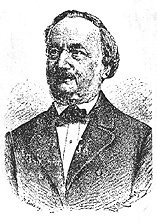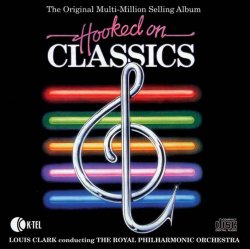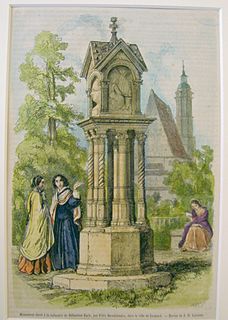
Felix Mendelssohn's six Organ Sonatas, Opus 65, were published in 1845. Mendelssohn's biographer Eric Werner has written of them: "Next to Bach's works, Mendelssohn's Organ Sonatas belong to the required repertory of all organists." [1]

Felix Mendelssohn's six Organ Sonatas, Opus 65, were published in 1845. Mendelssohn's biographer Eric Werner has written of them: "Next to Bach's works, Mendelssohn's Organ Sonatas belong to the required repertory of all organists." [1]
Mendelssohn was a skilled organist, and during his visits to Britain gave a number of well-received organ recitals. These often included the improvisations for which he was famous (e.g., at his recitals during his 1842 tour in London and Oxford). [2] In an article in the magazine Musical World of 1838, the English organist Henry John Gauntlett noted:
His execution of Bach's music is transcendently great [...] His extempore playing is very diversified – the soft movements full of tenderness and expression, exquisitely beautiful and impassioned [...] In his loud preludes there are an endless variety of new ideas [....] and the pedal passages so novel and independent [...] as to take his auditor quite by surprise. [3]
These qualities are evident in the organ sonatas, which were commissioned as a "set of voluntaries" by the English publishers Coventry and Hollier in 1844 (who also commissioned at the same time an edition by him of the organ chorales of J. S. Bach), [4] and were published in 1845. Correspondence between Mendelssohn and Coventry relating to the Sonatas took place between August 1844 and May 1845. Mendelssohn suggested that Gauntlett undertake the proof reading, but this was in fact probably carried out by Vincent Novello. [5] The publisher's original announcement referred to the work as "Mendelssohn's School of Organ-Playing" (see illustration), but this title was rescinded at the composer's request. [6]
One-hundred ninety subscribers to the publication produced a sales income of £199/10/-. Mendelssohn himself received £60 from the publisher, [7] equivalent to £6,000in 2019. [8] On this calculation, therefore, the price paid by each of the subscribers for the publication was equivalent in 2019 to £105.
In response to the commission, Mendelssohn at first drafted seven individual voluntaries, but then determined to extend and regroup them into a set of six sonatas, meaning by this not pieces in classical sonata form, but using the word as it had been used by Bach, for a collection or suite of varying pieces. [9] The sonatas include references to a number of Lutheran chorales, and No. 3 incorporates a processional piece which Mendelssohn had begun writing for the wedding of his sister Fanny in 1829. No 4 was the last to be written. [10]
The six sonatas are:

The sonatas demand good standards of pitch and touch from the organ and also a satisfactory pedalboard. Few English instruments were adequately equipped in these respects at the time, which probably explains the slow growth in interest in the pieces in Britain. Mendelssohn himself refused to play them when invited to do so at the Birmingham Festival of 1846, writing from Leipzig to his friend Ignaz Moscheles:
[T]he last time I passed through Birmingham the touch of the organ appeared to me so heavy that I could not venture to perform upon it in public. If however it is materially improved I shall be happy to play one of my sonatas; but I should not wish this to be announced before I had tried the organ myself. [11]
The first public performance in Britain of any of the sonatas was probably given by Edmund Chipp in 1846; [12] he also performed all six from memory in 1848. [13] Although British critics rated the music highly, often drawing attention to its echoes of the composer's improvisatory style, Mendelssohn himself never performed any of the sonatas in public, either in England or elsewhere. [14] He did however play them privately to the English music critic William Rockstro during the latter's visit to Frankfurt am Main in 1845, and wrote to his sister Fanny Mendelssohn in 1845 offering to play them to her. [15]
The sonatas were well received in other European countries, as they had been simultaneously published by Maurice Schlesinger in Paris, Ricordi in Milan, and Breitkopf & Härtel in Leipzig. Robert Schumann wrote to Mendelssohn in 1845 that he and his wife had played them over on the piano, and described them as "intensely poetical [...] what a perfect picture they form!" [16] They are likely to have prompted Schumann's Six Fugues on B-A-C-H, and, later in the century, the organ sonatas of Josef Rheinberger. [17]

Jakob Ludwig Felix Mendelssohn Bartholdy, born and widely known as Felix Mendelssohn, was a German composer, pianist, organist and conductor of the early Romantic period. Mendelssohn's compositions include symphonies, concertos, piano music, organ music and chamber music. His best-known works include the overture and incidental music for A Midsummer Night's Dream, the Italian Symphony, the Scottish Symphony, the oratorio St. Paul, the oratorio Elijah, the overture The Hebrides, the mature Violin Concerto and the String Octet. The melody for the Christmas carol "Hark! The Herald Angels Sing" is also his. Mendelssohn's Songs Without Words are his most famous solo piano compositions.

The Symphony No. 5 in D major/D minor, Op. 107, known as the Reformation, was composed by Felix Mendelssohn in 1830 in honor of the 300th anniversary of the Presentation of the Augsburg Confession. The Confession is a key document of Lutheranism and its Presentation to Emperor Charles V in June 1530 was a momentous event of the Protestant Reformation. This symphony was written for a full orchestra and was Mendelssohn's second extended symphony. It was not published until 1868, 21 years after the composer's death – hence its numbering as '5'. Although the symphony is not very frequently performed, it is better known today than when it was originally published. Mendelssohn's sister, Fanny Mendelssohn Hensel, chose the name Reformation Symphony.
The Symphony in C major by German composer Robert Schumann was published in 1847 as his Symphony No. 2, Op. 61, although it was the third symphony he had completed, counting the B-flat major symphony published as No. 1 in 1841, and the original version of his D minor symphony of 1841. It is dedicated to Oscar I, king of Sweden and Norway.

August Gottfried Ritter was a German romantic composer and organist.
Songs Without Words is a series of short lyrical piano songs by the Romantic composer Felix Mendelssohn, written between 1829 and 1845. His sister Fanny Mendelssohn and other composers also wrote pieces in the same genre.
Jacques-Nicolas (Jaak-Nicolaas) Lemmens, was an organist, music teacher, and composer for his instrument.

The Piano Trio No. 2 in C minor, Op. 66, was written by Felix Mendelssohn in 1845 and published in February 1846. The work is scored for a standard piano trio consisting of violin, cello and piano. Mendelssohn dedicated the work to his close friend and violinist, Louis Spohr, who played through the piece with the composer at least once.
Felix Mendelssohn's Cello Sonata No. 2 in D major, Op. 58, was composed in late 1842 — first half of 1843. The main theme of the first movement is a reworking of an unrealised Piano Sonata in G major. The Cello Sonata, which was dedicated to the Russian/Polish cellist Count Mateusz Wielhorski, has four movements:
An organ concerto is a piece of music, an instrumental concerto for a pipe organ soloist with an orchestra. The form first evolved in the 18th century, when composers including Antonio Vivaldi, George Frideric Handel and Johann Sebastian Bach wrote organ concertos with small orchestras, and with solo parts which rarely call for the organ pedal board. During the Classical period the organ concerto became popular in many places, especially in Bavaria, Austria and Bohemia, reaching a position of being almost an integral part of the church music tradition of jubilus character. From the Romantic era fewer works are known. Finally, there are some 20th- and 21st-century examples, of which the concerto by Francis Poulenc has entered the basic repertoire, and is quite frequently played.

Variations sérieuses, Op. 54, is a composition for solo piano by Felix Mendelssohn consisting of a theme in D minor and 17 variations. It was completed on 4 June 1841. A typical performance lasts about eleven minutes.

Edmund Thomas Chipp was an English organist and composer. His compositions were principally church organ music and oratorios.

The Clavier-Übung III, sometimes referred to as the German Organ Mass, is a collection of compositions for organ by Johann Sebastian Bach, started in 1735–36 and published in 1739. It is considered Bach's most significant and extensive work for organ, containing some of his most musically complex and technically demanding compositions for that instrument.
The Concerto for Two Pianos and Orchestra in A♭ major was written by Felix Mendelssohn when he was 15 years old. and is dated 12 November 1824. Written for two pianos and a full orchestra, the work received its first public performance in Berlin, in 1825. The composer and his mentor Ignaz Moscheles, who inspired its composition, were the soloists. He performed it again on 20 February 1827 at Stettin, where the cathedral organist, composer, baritone singer and conductor Carl Loewe organised concerts. Loewe and Mendelssohn were the two piano soloists on that occasion.
Felix Mendelssohn wrote thirteen string symphonies between 1821 and 1823, when he was between 12 and 14 years old.. These symphonies were tributes to Classical symphonies especially by Joseph Haydn, Johann Christian Bach, Carl Philipp Emanuel Bach, and Wolfgang Amadeus Mozart.

Hooked on Classics, produced by Jeff Jarratt and Don Reedman, is a multi-million selling album recorded by Louis Clark and the Royal Philharmonic Orchestra, published in 1981 by K-tel and distributed by RCA Records, part of the Hooked on Classics series.

The organ sonatas, BWV 525–530 by Johann Sebastian Bach are a collection of six sonatas in trio sonata form. Each of the sonatas has three movements, with three independent parts in the two manuals and obbligato pedal. The collection was put together in Leipzig in the late 1720s and contained reworkings of prior compositions by Bach from earlier cantatas, organ works and chamber music as well as some newly composed movements. The sixth sonata, BWV 530, is the only one for which all three movements were specially composed for the collection. When played on an organ, the second manual part is often played an octave lower on the keyboard with appropriate registration. Commentators have suggested that the collection might partly have been intended for private study to perfect organ technique, some pointing out that its compass allows it to be played on a pedal clavichord. The collection of sonatas is generally regarded as one of Bach's masterpieces for organ. The sonatas are also considered to be amongst his most difficult compositions for the instrument.

Tafelmusik is a collection of instrumental compositions by Georg Philipp Telemann (1681–1767), published in 1733. The original title is Musique de table. The work is one of Telemann's most widely known compositions; it is the climax and at the same time one of the last examples of courtly table music.

Throughout the 18th century, the appreciation of Johann Sebastian Bach's music was mostly limited to distinguished connoisseurs. The 19th century started with publication of the first biography of the composer and ended with the completion of the publication of all of Bach's known works by the Bach Gesellschaft. A Bach Revival had started from Mendelssohn's performance of the St Matthew Passion in 1829. Soon after that performance, Bach started to become regarded as one of the greatest composers of all times, if not the greatest, a reputation he has retained ever since. A new extensive Bach biography was published in the second half of the 19th century.